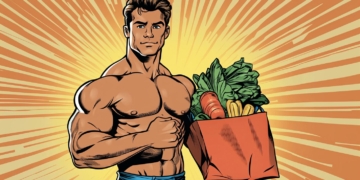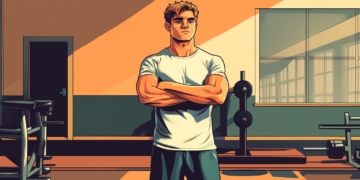Table of Contents
If you’re a skinny guy trying to bulk up, you already know the struggle is real. Every advantage counts—because let’s be honest, you’re not exactly drowning in muscle mass yet. The last thing you want is bad lifting gear slowing you down or draining your wallet.
The good news? You don’t need a suitcase of fancy gym toys to make gains. The bad news? There’s a sea of overhyped junk out there, and sorting through it can feel like a second job. But don’t worry—I’ve done the heavy lifting for you (pun intended).
Here’s a no-nonsense breakdown of the 7 best lifting gear essentials for skinny guys—gear that’ll actually help you lift heavier, avoid injuries, and recover faster.
1 Lifting Belt: Lift Heavy Without Folding Like a Lawn Chair
A lifting belt is like the gym buddy who won’t let you skip leg day. It keeps your core stable during squats and deadlifts, helping you lift heavier without your spine waving a white flag.
What to Look For:
A 4-inch leather belt. You don’t need the “look-at-me-I’m-a-powerlifter” version unless you’re lifting enough to scare gym newbies.
Why It’s Worth It:
A belt helps you brace your core and lift heavier with proper form, which means more gains and fewer chiropractor visits.
Pro Tip:
Save the belt for your heavy sets. If you’re wearing it during warm-ups, you’re just showing off—or you don’t trust your core strength.
2 Lifting Straps: When Your Grip Gives Up Before You Do
Ever been halfway through a deadlift and felt your grip give out? That’s where lifting straps save the day. They let you focus on pulling big weight, not holding onto the bar for dear life.
What to Look For:
Durable cotton or nylon straps. Affordable, unbreakable, and easy to use—even if you’re not a “DIY projects” kind of guy.
Why It’s Worth It:
Your back and legs can handle way more weight than your hands can grip. Straps let you hit your target muscles without your grip strength holding you back.
Pro Tip:
Use straps sparingly—max-effort sets only. If you’re strapping up for every pull, your grip is going to stay as weak as your excuses for skipping cardio.
3 Knee Sleeves: Save Your Knees, Save Your Gains
Squatting heavy can turn your knees into ticking time bombs if you’re not careful. Knee sleeves help keep your joints warm, stable, and safe—so you can squat like a beast without feeling like the Tin Man afterward.
What to Look For:
7mm thick knee sleeves are the sweet spot. Brands like Rehband or SBD are solid, but no need to drop major cash. Just make sure they’re snug and don’t slide down mid-squat.
Why It’s Worth It:
Knee sleeves reduce stiffness, prevent injuries, and give you the confidence to go heavy on squats. Plus, they make your legs look slightly less scrawny.
Pro Tip:
Use them for heavy squats or leg days. Let your knees fend for themselves during lighter sets—they need to toughen up, too.
4 Flat-Soled Shoes: Stop Lifting in Marshmallows
If you’re squatting or deadlifting in running shoes, stop immediately. Those cushy soles absorb all the force you’re trying to generate and make you as stable as a drunk flamingo.
What to Look For:
- Deadlifts: Converse Chuck Taylors or deadlift slippers.
- Squats: Lifting shoes with a raised heel (e.g., Nike Romaleos) to help you hit depth if your ankle mobility is trash.
Why It’s Worth It:
Proper shoes = better stability and power transfer. Translation: You’ll lift heavier and look less clueless in the gym.
Pro Tip:
Budget tip: Flat-soled sneakers (like Chucks) work for both lifts. Specialized shoes can come later when you’re lifting big boy weights.
5 Foam Roller: Love It or Hate It, You Need It
Foam rolling isn’t fun. In fact, it’s kind of like medieval torture—but it works. It loosens up tight muscles, improves mobility, and keeps you from waddling around like a penguin after leg day.
What to Look For:
High-density foam rollers are cheap and effective. Bonus points if it doubles as a weapon against people who curl in the squat rack.
Why It’s Worth It:
Foam rolling speeds up recovery and reduces soreness, so you can hit the gym harder and more often.
Pro Tip:
Spend 5–10 minutes rolling out your quads, hamstrings, and back. It’ll hurt, but you’ll thank me later.
Bonus Link: Learn proper foam rolling techniques with this NASM guide.
6 Weightlifting Chalk: Grip Like a Pro, Not a Sweaty Mess
Sweaty hands can ruin a heavy lift faster than bad form. Weightlifting chalk keeps your hands dry and your grip strong, so you can focus on lifting instead of slipping.
What to Look For:
Powder or liquid chalk. If your gym doesn’t allow chalk, opt for liquid, as it doesn’t leave a mess behind.
Why It’s Worth It:
Chalk improves grip instantly, especially during heavy deadlifts or pull-ups. It’s also ridiculously cheap.
Pro Tip:
Use chalk sparingly—don’t be that guy leaving white handprints on every piece of equipment.
7 Shaker Bottle: The Most Underrated Gym Accessory
Sure, it’s not as exciting as a new pair of lifting shoes, but a good shaker bottle is a must-have for skinny guys trying to bulk up. It keeps your protein shake handy and your hydration game strong.
What to Look For:
Leak-proof and dishwasher-safe. Ain’t nobody got time for scrubbing protein shake residue.
Why It’s Worth It:
Post-workout nutrition is key for recovery and growth. A good shaker bottle ensures you’re getting those gains without choking down lumpy protein sludge.
Pro Tip:
Pre-mix your shake before your workout and leave it in your gym bag. No excuses for skipping post-workout protein.
8 The Bottom Line
The best lifting gear for skinny guys isn’t about looking cool—it’s about lifting smarter. Start with these essentials: a lifting belt for core stability, straps for grip support, knee sleeves for joint safety, and proper shoes for better performance. Sprinkle in a foam roller, chalk, and a shaker bottle, and you’re set to crush your workouts.
Got a favorite piece of gym gear? Drop it in the comments and let’s compare notes.





